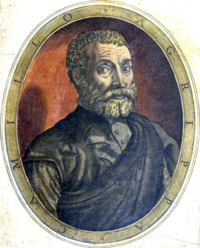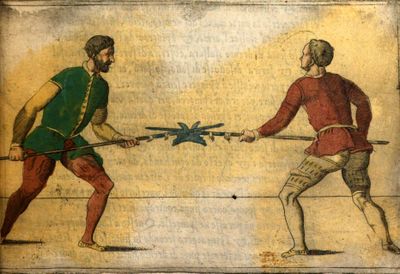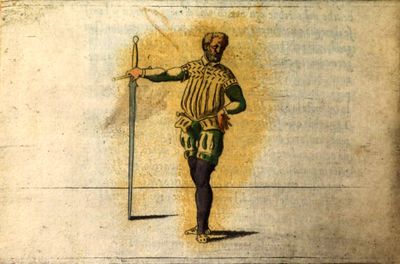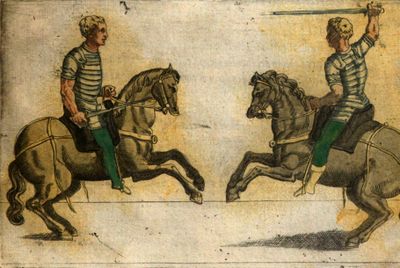|
|
You are not currently logged in. Are you accessing the unsecure (http) portal? Click here to switch to the secure portal. |
Difference between revisions of "Camillo Agrippa"
| Line 67: | Line 67: | ||
! <p>Images</p> | ! <p>Images</p> | ||
! <p>{{rating}}</p> | ! <p>{{rating}}</p> | ||
| − | ! <p>Transcription</p> | + | ! <p>Transcription (1553){{edit index|Trattato di Scientia d'Arme, con vn Dialogo di Filosofia (Camillo Agrippa) 1553.pdf}}</p> |
|- | |- | ||
| Line 85: | Line 85: | ||
! <p>Images</p> | ! <p>Images</p> | ||
! <p>{{rating}}</p> | ! <p>{{rating}}</p> | ||
| − | ! <p>Transcription</p> | + | ! <p>Transcription (1553){{edit index|Trattato di Scientia d'Arme, con vn Dialogo di Filosofia (Camillo Agrippa) 1553.pdf}}</p> |
|- | |- | ||
| Line 103: | Line 103: | ||
! <p>Images</p> | ! <p>Images</p> | ||
! <p>{{rating}}</p> | ! <p>{{rating}}</p> | ||
| − | ! <p>Transcription<br/>by [[Niccolò Menozzi]]</p> | + | ! <p>Transcription (1553){{edit index|Trattato di Scientia d'Arme, con vn Dialogo di Filosofia (Camillo Agrippa) 1553.pdf}}<br/>by [[Niccolò Menozzi]]</p> |
|- | |- | ||
| Line 141: | Line 141: | ||
! <p>Images</p> | ! <p>Images</p> | ||
! <p>{{rating}}</p> | ! <p>{{rating}}</p> | ||
| − | ! <p>Transcription<br/>by [[Niccolò Menozzi]]</p> | + | ! <p>Transcription (1553){{edit index|Trattato di Scientia d'Arme, con vn Dialogo di Filosofia (Camillo Agrippa) 1553.pdf}}<br/>by [[Niccolò Menozzi]]</p> |
|- | |- | ||
| Line 160: | Line 160: | ||
! <p>Images</p> | ! <p>Images</p> | ||
! <p>{{rating}}</p> | ! <p>{{rating}}</p> | ||
| − | ! <p>Transcription</p> | + | ! <p>Transcription (1553){{edit index|Trattato di Scientia d'Arme, con vn Dialogo di Filosofia (Camillo Agrippa) 1553.pdf}}</p> |
|- | |- | ||
| Line 180: | Line 180: | ||
| work = Images | | work = Images | ||
| authors = | | authors = | ||
| − | | source link = https://books.google.it/books?id=y5xbAAAAcAAJ | + | | source link = https://books.google.it/books?id{{=}}y5xbAAAAcAAJ |
| source title= Google Books | | source title= Google Books | ||
| license = public domain | | license = public domain | ||
Revision as of 21:45, 22 July 2020
| Camillo Agrippa | |
|---|---|
 | |
| Born | 1510s (?) Milan, Italy |
| Died | 1595 Rome, Italy |
| Occupation |
|
| Influenced | |
| Genres | Fencing manual |
| Language | Italian |
| Notable work(s) | |
Camillo Agrippa (1510s–1595) was a 16th century Italian architect, engineer, and fencer. Born in Milan, Agrippa moved to Rome on 26 October 1535 and later became associated with the Confraternity of St. Joseph of the Holy Land. He also moved in literary and artistic circles, where he was acquainted with Cardinal Alessandro Farnese and the great artist Michelangelo.
Though he doesn't seem to have been a professional fencing master, Agrippa stands out as one of the most influential fencing theorists in history. His first treatise, titled Trattato di Scientia d'Arme, con vn Dialogo di Filosofia ("Treatise on the Science of Arms, with a Philosophical Dialogue"), was published in 1553 and presented a unique new system of swordsmanship based on his knowledge of geometry and mechanics.
Agrippa's theories revolutionized civilian fencing and presaged the emergence of the thrusting style that characterized the use of the rapier. The influence of his ideas is seen in virtually every fencing manual published in the subsequent century, including those of Ridolfo Capo Ferro da Cagli, Jerónimo Sánchez de Carranza, Salvator Fabris, and Henry de Sainct Didier. It is unclear, however, whether this is due to his direct influence, or if Agrippa was merely among the first to describe a general change in the culture of fencing that was much larger than his work.
Contents
Treatises
Images |
Transcription (1553) | |
|---|---|---|
Images |
Transcription (1553) | |
|---|---|---|
Images |
Transcription (1553) | |
|---|---|---|
[60v] Cap. XXIIII. Dovendo essere, per qual cagion' si voglia: per conseguir la vittoria, cosi presta la mano à la uendetta, come sia l'animo: al mio parere ogni Pompa, & vana dimostratione, che si faccia con l'arme, sarà di preiuditio à chi l'usarà. Percio lassando da parte il ragionarne, seguirò a' parlare de la sustanza, come ho fatto fin' hora. & essendo à l'arme d'Asta dico, se vno farà vna finta di fore, verso la parte manca del nemico, accio venghi à parare, subito deuerà sfalsar l'arme, & spingere da l'altra banda, se farà la finta di drento sfalsarà, et ferira di fore: se di sopra, sfalsarà, & ferirà di sotto: se di sotto, sfalsara', et ferira di sopra. | ||
Et se la parte venisse à spingere senza parare: l'altra in scambio di sfalsare, pararà, et spingerà, per quella via che fece la finta: se di fore, pari, et spenga di fore: se di drento, pari, & spenga di drento: se di sopra, pari, et spinga di sopra: se di sotto, pari et spinga di sotto: oltra che potrà battere, & spingere di lanciata da trauerso: & questo da ogni banda, da man' dritta, ouero da mano manca, tenendo il calce de l'asta in quella mano, con la quale si lanciarà l'arme: et quando l'auersario suo non spinga, esso finga, & spinga, ouero finga, contrapassi, et spinga. | ||
Et s'il nimico non parasse ne spingesse, Questo à l'hora doppo la finta, finga batti, & spinga: pero secondo la finta, se finge di fore, batti, et spinga di fore: se finge di drento, batti et spinga di drento: & cosi per ogni uerso. | ||
[61] Et se li sopradetti si ritrouassero come si vede nel presente atto, benche iudicarebbe ogn'uno, che'vno di maggior forza n'hauesse il meglio: nondimeno vno di minore per auantaggio suo spingendo, & nel spinger' fermandosi, per inuitare il nemico à spingere quanto ponno le forse sue, & nel medesimo tempo ch'il nemico spingesse, Questo disarmando col tirar' à dietro, et accompagnando la forza del nemico in fore, potria andare ad inuestirlo lassando la botta del nemico uota. | ||
Et quando anco fossero attaccati insieme con li vnzini, & ogn'vno tirasse per auantaggiar' la botta, quello di minor forza tirando potria andare col pie dritto appresso il manco, mostrando la vita in piano à l'auersario, perche à l'hora ceda, & spinga contra di lui, & girando in vn subito adietro con la vita, accompagnarebbe l'arma del nemico in fore, & rimettendo la sua, andaria ad inuestirlo crescendo col pie manco. et se pur' la maggior forza non spingesse, ne cedesse, ma tirasse à se: nel medesimo tempo la minore passando à mano manca, spingeria vna botta determinata ragioneuolmente. |
Images |
Transcription (1553) | |
|---|---|---|
|
[61v] Cap. XV. Havevo disignato dire ancora come si adoperasse il Spadone: ma considerato meglio che quanto si potesse dire sarebbe uano, per la incerta regola de le sue botte le quali uanno per l'aria: mi è parso con sotisfattion' di chi lo sà adoperare, & chi non sà, las- [62] sar' di ragionarne, non potendo essere, eccetto una confusione d'intelletto ogni auiso, & disciplina che se ne desse, senza il proprio essercitio, ouero effettual demostratione, da alcuno de la professione: auertendo solamente, che ritrouandosi doi con spadoni potranno fare di punta quelle botte medesime, che si sono descritte di sopra de l'arme d'Asta. |
Images |
Transcription (1553) | |
|---|---|---|
For further information, including transcription and translation notes, see the discussion page.
| Work | Author(s) | Source | License |
|---|---|---|---|
| Images | Google Books | ||
| Transcription | Niccolò Menozzi | Index:Trattato di Scientia d'Arme, con vn Dialogo di Filosofia (Camillo Agrippa) 1553.pdf |
Additional Resources
- Agrippa, Camillo. Fencing: A Renaissance Treatise. Ed. Ken Mondschein. New York: Italica Press, 2009. ISBN 978-1-59910-129-3
- Agrippa, Camillo and Swanger, W. Jherek. A Treatise on the Science of Arms, with a Philosophical Dialogue, by Camillo Agrippa: an Annotated Translation. Lulu, 2018.
References




